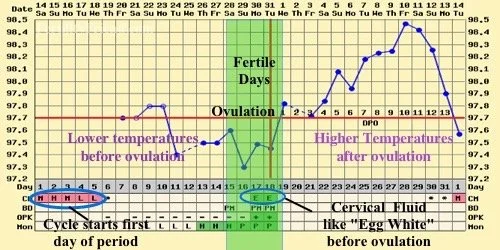Basal Temperature Tracking
Basal temperature tracking involves monitoring your body's basal body temperature (BBT) on a daily basis to track changes throughout your menstrual cycle. Basal body temperature refers to your body's temperature at rest, typically measured first thing in the morning before you get out of bed. By tracking your BBT over time, you can identify patterns in your menstrual cycle, including when you ovulate and when you may be most fertile. This method is often used by individuals who are trying to conceive or who are monitoring their reproductive health.
The best tracking method for basal temperature is to use a basal body thermometer specifically designed for this purpose. Basal body thermometers are more sensitive and accurate than regular thermometers, allowing you to measure your BBT with precision to two decimal places.
To track your basal temperature effectively, follow these steps:
Take your temperature at the same time every morning: It's important to measure your BBT at the same time each day, ideally before getting out of bed or engaging in any physical activity. Consistency in timing is key to obtaining reliable data.
Use a basal body thermometer: Make sure to use a dedicated basal body thermometer that is designed to detect small changes in temperature accurately. Keep the thermometer within reach of your bed to minimise movement before taking your temperature.
Record your temperature daily: Keep a record of your BBT readings on a chart or in a tracking app. Note any factors that may affect your temperature, such as illness, alcohol consumption, lack of sleep, or irregular sleep patterns.
Chart your BBT over time: By tracking your BBT over several menstrual cycles, you can identify patterns and changes that may indicate ovulation, fertility, or hormonal imbalances. Look for a rise in temperature after ovulation, which typically indicates the start of the luteal phase.
Consider additional fertility signs: In addition to tracking your BBT, you may also monitor other fertility signs such as cervical mucus, cervical position, and ovulation predictor kits to enhance your understanding of your menstrual cycle.
By following these steps and using a reliable basal body thermometer, you can effectively track your basal temperature and gain valuable insights into your reproductive health and
https://www.fertilityfriend.com/Faqs/Reading-the-chart.html
The basal temperature chart signifies changes in your body's basal body temperature (BBT) throughout your menstrual cycle. By tracking your BBT daily and charting it over time, you can observe patterns that may indicate when you ovulate, when you are most fertile and when your period is likely to start.
Your cervical fluid gets increasingly wet and slippery as you get closer to ovulation. When it is most slippery and wet, that is when you are most fertile. This increase in cervical fluid production is caused by the hormone estrogen, which is released by the ovarian follicle as it is maturing and getting ready to release an egg at ovulation. You should have intercourse when you have this kind of fluid because it indicates that ovulation is approaching and it nourishes and transports sperm while they are waiting for the egg to be released. Ideally, you want to have sperm waiting in your reproductive system when the egg is released.
Typically, in the first half of your menstrual cycle (the follicular phase), your BBT tends to be lower. As you approach ovulation, there is often a slight dip in temperature followed by a noticeable rise in BBT. This temperature shift indicates that ovulation has occurred and that you have entered the second half of your cycle (the luteal phase), during which your BBT remains elevated. If fertilisation does not occur, your BBT will eventually drop again, signalling the onset of your period.
It's important to note that individual variations in BBT patterns can occur, so it's recommended to track your BBT over several cycles to establish a reliable baseline and recognise your unique patterns.

